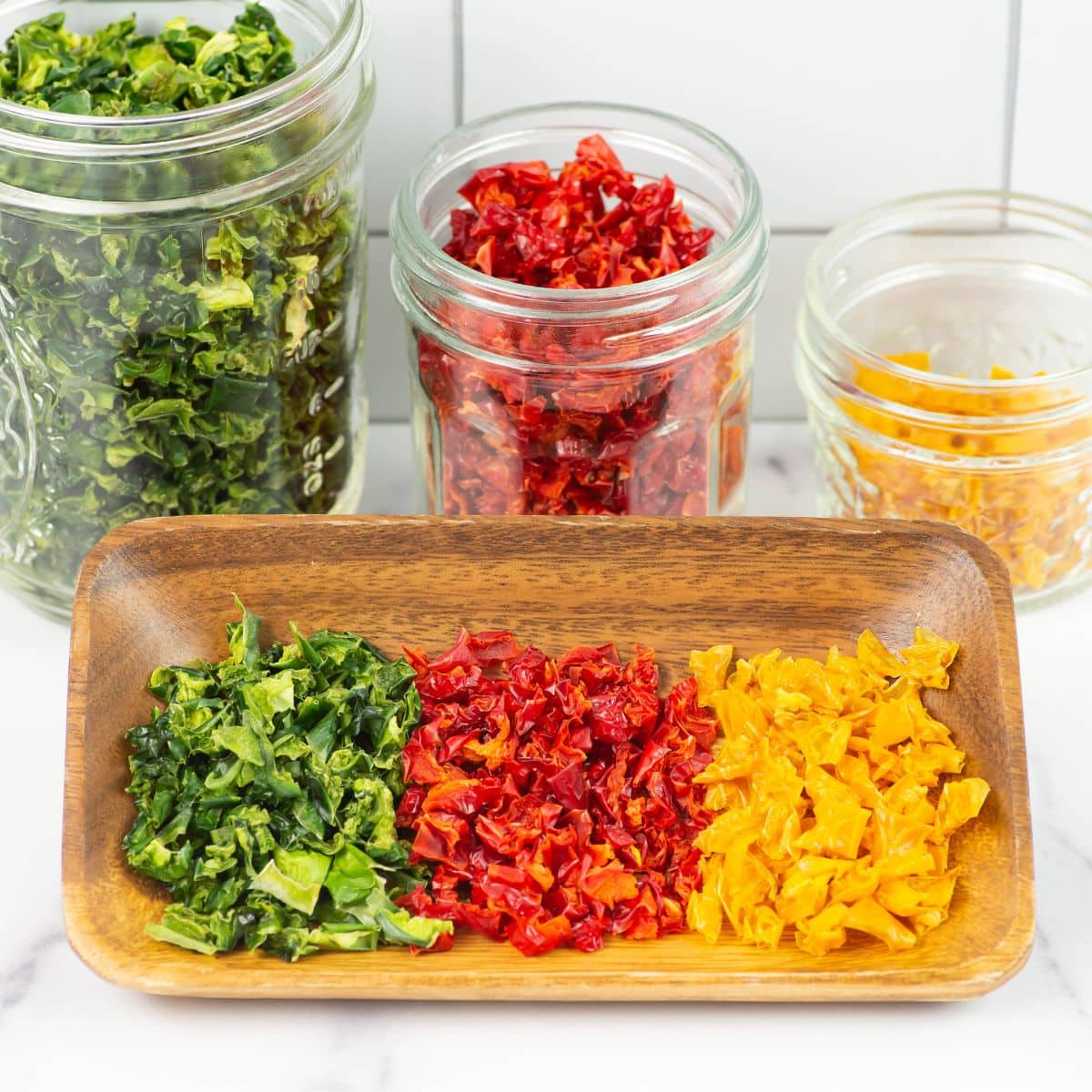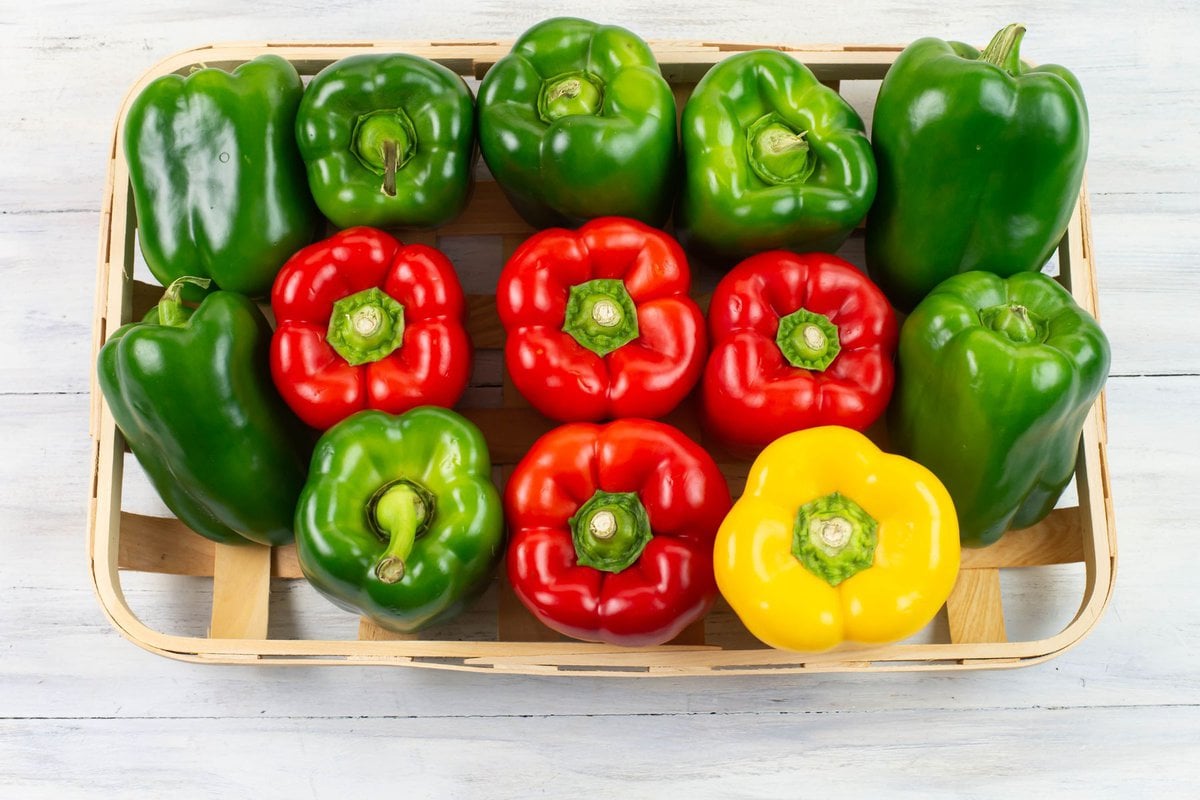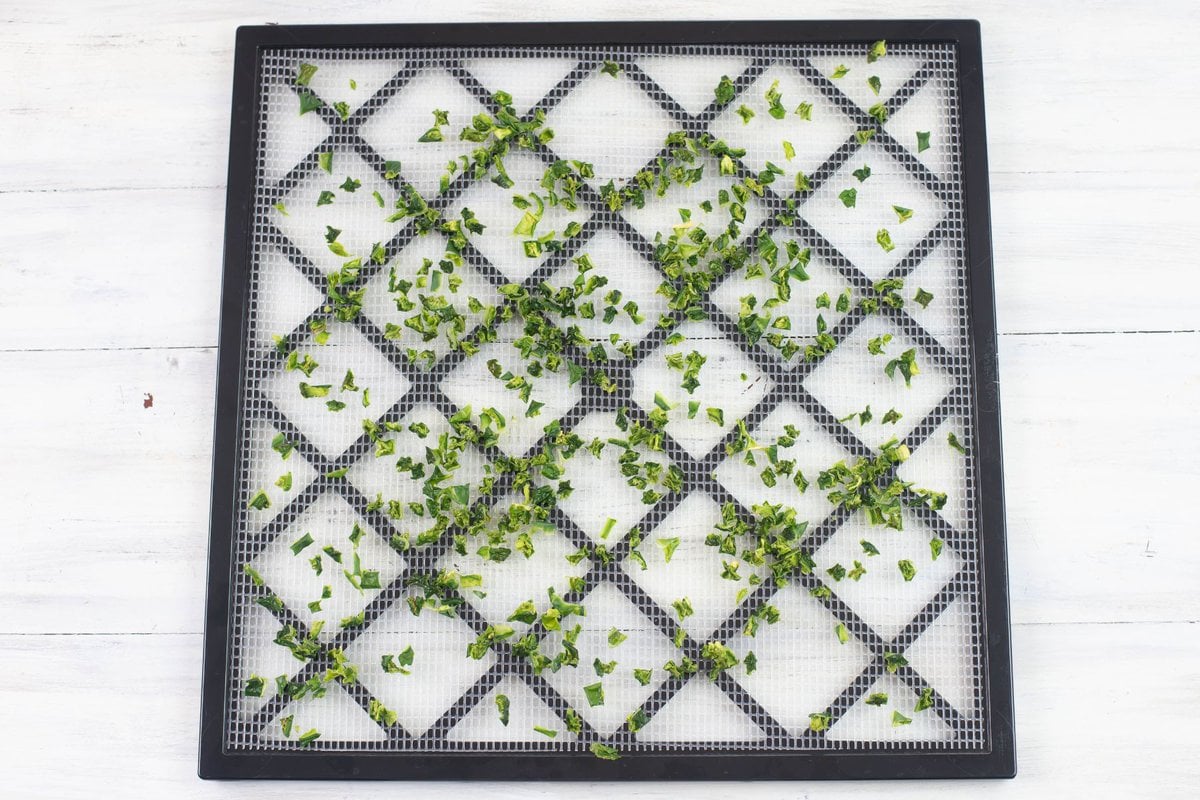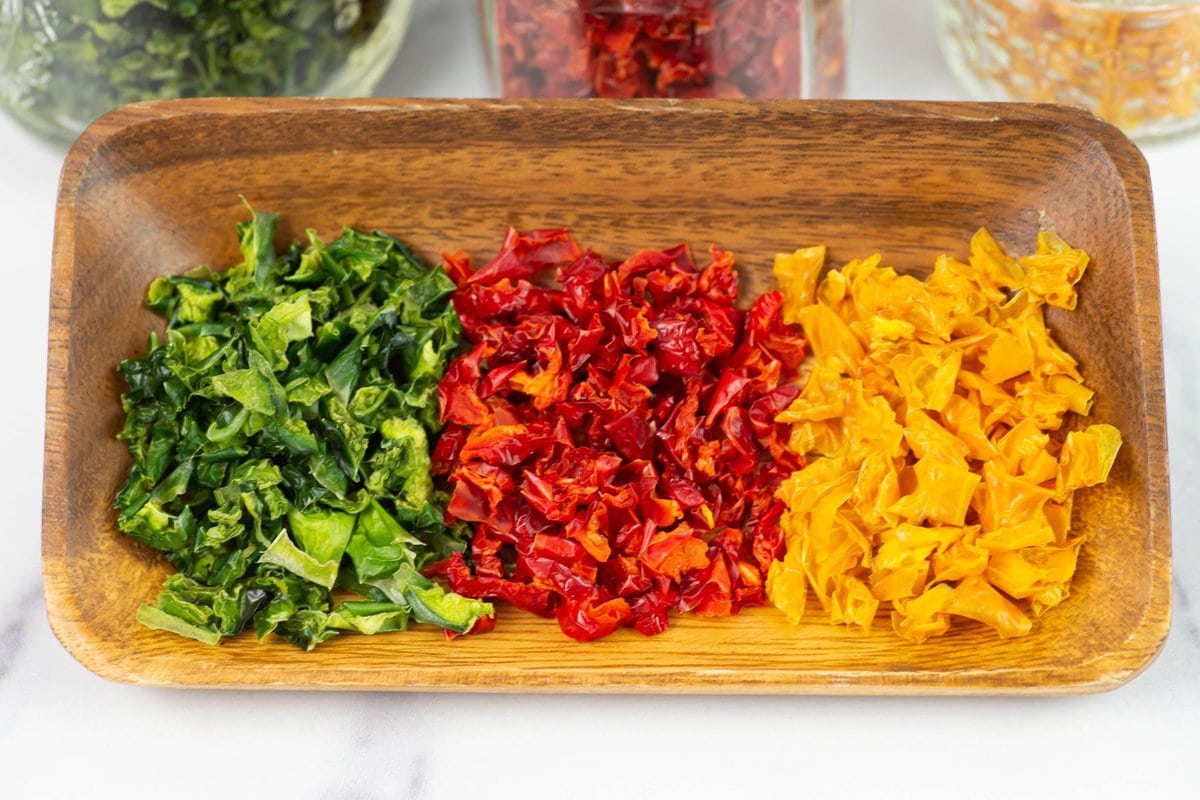Are you looking for an easy way to save money and make sure your pantry is always stocked with sweet bell peppers? Food Dehydrator recipes is the key!
Dehydrating them is an ideal solution. With this guide, you will learn how to dehydrate bell peppers and store them for use in any recipe, year-round.

Dehydrating bell peppers is a tried-and-true method for longer storage that is recommended by food storage experts.
You'll be able to make the most of any seasonal abundance of bell peppers from your garden, the farmers market or when you find them on sale for a great price at the grocery store.
Are you tired of tossing out spoiled bell peppers because you forgot to use them?
With the dehydrating method, you can store them for long periods of time, saving you money and reducing food waste.
In this post, I will guide you through the step by step process of dehydrating bell peppers for long-term storage.
You will be able to enjoy the fresh flavor of bell peppers in-season and off-season without spending too much. So, let's get dehydrating!
FREE Dehydrator Guide
New to dehydrating and not sure where to start? Grab my free Dehydrating Quick Guide to get started.
What you'll need to get started
- fresh ripe bell peppers: Only use ripe and unblemished sweet green, red, orange or yellow bell peppers. All colors and types of peppers can be dried in a dehydrator.
- a food dehydrator: there are many options available when buying a food dehydrator. The prices range for about $50 to several hundreds. I have an inexpensive round dehydrator and a Excalibur box dehydrator. I use them both.
- a sharp knife or a vegetable chopper: a sharp knife works great to cut thin slices of peppers and can be used to cut diced bell peppers. A vegetable chopper works better than a knife if you plan on dehydrating a large amount of diced peppers.
- a cutting mat or board to protect your counter surface
- water: to clean the peppers
- dried pepper storage: air tight food grade containers for storing the dried peppers
- somewhere dark and cool to store the containers of dehydrated peppers
Selecting the Right Bell Peppers
When it comes to dehydrating bell peppers or dehydrating vegetables in general selecting the right peppers is crucial.
You'll want to choose peppers that are fresh and in their prime, as they will dehydrate better and retain more of their nutrients and flavor than older, wilted peppers.
Look for firm ripe, brightly colored peppers that are free of soft spots or blemishes.

While all colors of bell peppers can be dehydrated, some people prefer to use red or yellow peppers as they have a sweeter flavor.
However, if you prefer the taste of green bell peppers, go ahead and use those.
By taking the time to select the right bell peppers, you'll set yourself up for success when it comes to dehydrating and storing them for the long term.
So next time you're at the grocery store or farmer's market, keep these tips in mind to ensure you're choosing the best peppers for your dehydrating needs.
Now that you know how to select the best bell peppers for dehydration, let's move on to the next step: preparing the peppers for dehydration.,
Preparing Bell Peppers for Dehydration
Now that you've chosen the best bell peppers for your dehydration needs, it's time to prepare them for the process.
Start by washing the peppers thoroughly under cold running water and patting them dry with a clean towel.
I like to use a plastic tub that fits in my sink. I'll run the cold water over the peppers and let them soak for a minute to remove any loose dirt. I then dump the water and repeat until the peppers are clean.
Next, remove the stem and cut the peppers into slices, strips, or cubes, depending on your preference. It's important to ensure that the pieces are of uniform thickness to ensure even drying.
Do bell peppers need to be blanched before dehydrating?
If you're dehydrating a large batch of peppers, blanching them beforehand can help to speed up the drying process.
Blanched vegetables dry faster and retain their bright fresh colors better. Blanching bell peppers is a personal choice. They do not need to be blanched before dehydrating.
How to blanch bell peppers
If you decide you want to blanch them before drying them it is very easy to do.
Before blanching prep them into the sliced, cubed or diced size that you plan to dehydrate them in.
- To blanch bell peppers: Bring a large pot of water to a boil. Once the water is boiling the pepper pieces to the water. After 2 minutes in the boiling water dump the peppers into a colander with very fine small holes to drain.
- Immediately plunge the drained peppers into a bowl of ice water to stop the cooking process.
- Drain well to remove as much water as possible. You can also pat the pieces dry with a lint free dish towel.
Dehydrating Bell Peppers
When it comes to dehydrating bell peppers, there are a few things to keep in mind to ensure the best results.
First and foremost, it's important to slice the peppers evenly and to remove all the seeds and membranes. This will not only make the dehydration process more efficient but will also result in a more uniform finished product.
Now that your bell peppers are cleaned, cut into diced peppers or slices, you're ready to begin the dehydration process.
Whether using a dehydrator or an oven, it's important to follow these instructions for the best results.
Generally, all vegetables as well as sweet bell peppers should be dried at a low temperature for several hours until they are completely dry and are leathery or brittle to the touch.

Directions
- Step 1: Cut the cap off the top of each bell pepper. Remove the core and seeds. Cut each pepper in half or in quarter pieces. Remove the seeds and pull or cut off the piece of membrane between the pepper sections.

- Step 2: Use a sharp knife or a vegetable chopper to cut the peppers into strips or cubes. Cut the slices or cubes into ¼ to ½ inch thickness. Repeat with all of the peppers.

- Step 3: Arrange the pieces on the dehydrator trays. Spread the bell pepper pieces over dehydrator trays that have been lined with a mesh screen tray liner to prevent the smaller pepper pieces from falling through the trays.

Repeat until all of the bell peppers have been arranged in a semi single layer on the trays. They don't have to be spaced far apart like some fruits or vegetables.

Slide or stack the filled trays in the dehydrator and place the door or lid on.
Step 4: Turn the dehydrator on. If the dehydrator you are using has a temperature control setting set it to 125ºF (52ºC). Place the lid on or close the door and dehydrate the bell peppers for 6 to 11 hours or until the bell peppers are dry through the center and feel dry and leathery or brittle. Drying times will vary. The size of the cut and the color of the pepper will affect the drying times.
- Green peppers can take 6 to 8 hours to dry.
- Red, yellow or orange peppers can take from 6 to 12 hours to dry.
Periodically check the peppers for doneness. I will check them every two hours to start with. The closer they get to a leathery texture I will check more often.

Step 5: Once the peppers have reached a leathery to crisp texture they are done. Turn off the dehydrator and allow the peppers to cool to room temperature.
After they have cooled transfer them to a airtight container for storage.
Example of fresh vs dehydrated bell peppers
Check out the pictures below to see an example of how much green bell peppers will shrink from drying.



Bonus Expert Tips
- If you are drying red, yellow, or orange bell peppers keep each of the different colored diced pieces separate as you dehydrate them. I have found that red, yellow and orange bell peppers take longer to dehydrate than the green bell peppers. It is because they have a higher sugar content than the green peppers. You will not want to mix them with the green peppers.
- The green peppers will be dry way sooner than the colored peppers. This will also allow you to store the individual color dried peppers separately.

Storing Dehydrated Bell Peppers
With your dehydrated bell peppers ready to go, the next step is to store them properly to ensure their long-term preservation.
- First, make sure the peppers are completely dry and cool before storing. Any remaining moisture can lead to spoilage or mold.
- Next, you have a few options for storage containers. Mason jars with tight-fitting lids work well, as do airtight bags or containers.
- It's important to keep the peppers in a cool, dry place, away from direct sunlight or any sources of heat. A dark pantry or cupboard is a good choice for storage.
- Some people like to add an oxygen absorber packet to their storage container to help prolong the shelf life of the peppers.
While this is optional, it can be helpful in keeping the peppers fresh for longer periods.
How long do dehydrated bell peppers last?
When stored properly, dehydrated bell peppers can last for up to a year or more. This makes them a handy addition to your pantry, ready to add to your favorite recipes whenever you need them.
Using dehydrated bell peppers in your favorite recipes is easy and convenient. Whether you're adding them to soups, stews, or pasta dishes, they add a burst of flavor and nutrition.
Let's take a look at some creative ways to use your dehydrated bell peppers in the kitchen.,
Using Dehydrated Bell Peppers in Your Favorite Recipes
Dehydrated bell peppers may seem like an odd ingredient to those unfamiliar with their versatility, but they can add a world of flavor to your favorite dishes. Here are a few ideas to help get you started:
- Add to Soups and Stews: Adding dehydrated bell peppers to soups and stews is an easy way to add a pop of color and flavor to your recipe. Simply rehydrate the peppers by soaking them in hot water for 15-20 minutes before adding them to the pot. Or add them to the pot with the liquids and they will rehydrate as they absorb the water or broth.
- Incorporate into Pasta Dishes: Rehydrated dehydrated bell peppers are a great addition to any pasta dish. Whether you're making a classic spaghetti or a creamy pasta salad, they add a layer of flavor that you won't want to miss.
- Use as a Topping: Dehydrated bell peppers can also be used as a topping for pizzas, flatbreads, and salads. Simply rehydrate them beforehand to ensure they don't burn in the oven.
- Blend into Spices: If you're feeling adventurous, try blending dehydrated bell peppers into your favorite spice blend for a unique twist. The possibilities are endless when it comes to using dehydrated bell peppers in your favorite recipes.
As you can see, there are many creative ways to utilize dehydrated bell peppers in your kitchen. Experiment with different recipes and see how they can enhance the flavors of your favorite dishes.
Recipe FAQs
Wash the peppers and cut them into strips or diced pieces before dehydrating.
Dried bell peppers can be used to flavor recipes and dishes just like fresh. Simply rehydrated them in hot water, drain and toss into the pot.
Dried bell peppers can last months to years depending on the storage method you use. Dried peppers stored in a plastic bag will only last a short while. While dried peppers stored in an airtight or vacuum seal container can last for years.
Expert Recipe Tips
- fresh bell peppers: pick fresh unblemished sweet bell peppers for dehydrating.
- mesh liners: Line your dehydrator trays with mesh liners or the dried pieces will fall through the larger hole of the dehydrator tray. Mesh liners are available for every type of food dehydrator.
- drying times will vary: Bell peppers can take anywhere from 4 hours to 12 hours to dehydrate. Separate the green, red, yellow and orange pepper pieces and dry them separately.
- dehydrated size: keep in mind that the pepper pieces will shrink to more than half the size as they dry.

Dehydrating bell peppers is a simple and cost-effective way to add flavor to your meals all year round. With the right equipment and my step-by-step guide, you can stock up on this versatile ingredient for months or even years.
So why not start dehydrating today and never waste a bell pepper again?
More Dehydrating Recipes
Make more dried fruits and vegetables to stock your pantry all year long.
Email questions or recipe requests to flouronmyface@gmail.com. Follow me on Pinterest, YouTube, Instagram and Facebook.

How to Dehydrate Bell Peppers
Equipment
Ingredients
- 13 large green, red, or yellow bell peppers
- 1 tub cold water
Instructions
Prep
- Wash the bell peppers in a tub of cold water to clean any dirt or debris. Repeat if needed. Pat dry with a lint free towel.
How Dehydrate Bell Peppers
- Cut the cap off the top of each bell pepper. Remove the core and seeds. Cut each pepper in half or in quarter pieces. Remove the seeds and pull or cut off the piece of membrane between the pepper sections.
- Cut the bell peppers into ¼ inch strips or ¼ to ½ inch dice or cubes using a sharp knife or a chopper. Repeat with all of the peppers.
- Spread the diced or sliced bell pepper pieces in a single layer over dehydrator trays that have been lined with a mesh screen to prevent the smaller pieces from falling through the trays as they dry and shrink. Repeat until all of the pieces have been arranged on trays.
- If the dehydrator has a temperature control set the temperature to 125 degrees. Place the lid on or close the door and dehydrate the bell peppers for 6 to 11 hours or until the bell peppers are dry through the center and feel dry and leathery to the touch.
- Once the bell peppers are dry allow them to cool completely.
- Transfer the dried and cooled sweet bell pepper pieces to an air tight container. Store the container in a dark cool cabinet.
- Use the dried bell pepper to season soups, stews and other recipes. Or grind the dried peppers into a powder to make your own custom blends of seasonings.
Recipe Expert Tips
-
- fresh bell peppers: pick fresh unblemished sweet bell peppers for dehydrating.
-
- mesh liners: Line your dehydrator trays with mesh liners or the dried pieces will fall through the larger hole of the dehydrator tray. Mesh liners are available for every type of food dehydrator.
-
- drying times will vary: Bell peppers can take anywhere from 4 hours to 12 hours to dehydrate. Separate the green, red, yellow and orange pepper pieces and dry them separately.
-
- dehydrated size: keep in mind that the pepper pieces will shrink to more than half the size as they dry.













Marie
I have done this and when I grind then and put in air tight container they still clump together WHY?
Arlene Mobley
Marie it sounds like they have not been dehydrated long enough. Moisture is what causes it to lump together.
Estelle Forrest
This is so useful! I am hopeful that my bell peppers flourish this year in the garden so that I can make these! Thanks so much for linking up on SSPS, hope to see you again next week.